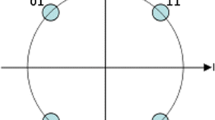Abstract
Space Time Constellation Rotating Codes (STCRs) achieve a rate of 1 symbol/s/Hz and enjoy a diversity N tNr for arbitrary number of transmit and receive antennas N t and N r over quasi static fading channels. Optimum Unitary STCRs based on Algebraic design tools, which achieve the upper bound on coding gain for all linear precoders over Quadrature Amplitude Modulation (QAM) and Pulse Amplitude Modulation (PAM), are known only when the number of transmit antennas is power of two. In this paper we design optimum unitary LCPs for even number of transmit antennas. We also present some unitary precoders for odd number of transmit antennas which clearly out-perform the existing unitary non-optimum precoders. Performance results corroborate our analysis.
Similar content being viewed by others
References
S.M. Alamouti, “A Simple Transmit Diversity Technique for Wireless Communications”, IEEE J. Select. Areas Commun., Vol. 16, pp. 1451–1458, Oct. 1998.
V. Tarokh, H. Jafarkhani, and A.R. Calderbank, “Space-Time Block Codes from Orthogonal Designs”, IEEE Trans. Inform. Theory, Vol. 45, pp. 1456–1466, July 1999.
V. Tarokh, N. Seshadri, and A. Calderbank, “Space-Time Codes for High Data Rate Wireless Communications: Performance Criterion and Code Construction”, IEEE Trans. Inform. Theory, Vol. 44, pp. 744–765, Mar. 1998.
G.J. Foschini, “Layered Space-time Architecture for Wireless Communication in a Flat Fading Environment when Using Multi-Element Antennas”, Bell Labs. Tech. J., Vol. 1
Y. Xin, Z. Liu, and G.B. Giannakis, “High-Rate Layered Space-Time Transmissions Based on Constellation-Rotation”, in Proc. Wireless Communications and Networking Conf., Orlando, FL, pp. 471–476, Mar. 17–21, 2002.
Y. Xin, Z. Wang, and G.B. Giannakis, “Linear Unitary Precoders for Maximum Diversity Gains with Multiple Transmit and Receive Antennas”, in Proc. 34th Asilomar Conf., Pacific Grove, CA, pp. 1553–1557, Oct. 29–Nov. 1 2000.
Y. Xin, Z. Wang, and G.B. Giannakis, “Space-Time Diversity Systems Based on Unitary Constellation-Rotating Precoders”, in Proc. Int. Conf. ASSP, Salt Lake City, UT, pp. 2429–2432, May 7–11, 2001.
Y. Xin, Z. Wang, and G.B. Giannakis, “Space-Time Constellation-Rotating Codes Maximizing Diversity and Coding Gains”, GLOBECOM '01, Vol. 1, pp. 455–459, 25–29 Nov. 2001
Y. Xin, Z. Wang, and G.B. Giannakis, “Space-Time Diversity Systems Based on Linear Constellation Precoding”, IEEE Transactions on Wireless Communications, Vol. 2, No. 2, Mar. 2003.
J. Boutros, E. Viterbo, C. Rastello, and J.C. Belfiore, “Good Lattice Constellations for Both Rayleigh Fading and Gaussian Channel”, IEEE Trans Inform. Theory, Vol. 42, pp. 502–518, Mar. 1996.
J. Boutros and E. Viterbo, “Signal Space Diversity: A Power and Bandwidth Efficient Diversity Technique for the Rayleigh Fading Channel”, IEEE Trans. Inform. Theory, vol. 44, pp. 1453–1467, July 1998.
V.M. DaSilva and E.S. Sousa, “Fading-Resistant Modulation Using Several Transmitter Antennas”, IEEE Trans. Commun., Vol. 45, pp. 1236–1244, Oct. 1997.
M.O. Damen, K. Abed-Meraim, and J.C. Belfiore, “Generalized Sphere Decoder for Asymmetrical Space-Time Communication Architecture”, Elec. Letters, Vol. 36, p. 166, Jan. 2000.
E. Viterbo and J. Boutros, “A Universal Lattice Code Decoder for Fading Channels”, IEEE Trans. on Inform. Theory, Vol. 45, pp. 1639–1642, July 1999.
A. Paulraj, R. Nabar, and D. Gore, Introduction to Space Time Wireless Communications, Cambridge University Press, 2003.
E. G. Larson and P. Stoica, Space-Time Block Coding for Wireless Communications, Cambridge University Press, 2003
Author information
Authors and Affiliations
Corresponding author
Additional information
Manav R. Bhatnagar was born in Moradabad, India in 1976. He did his B.E. in Electronics in 1997 and Master of Technology in Communications Engineering in 2005 from Indian Institute of Technology Delhi, India. He has worked as lecturer in Moradabad Institute of Technology, Moradabad, India from 1998--2003. He is currently pursuing PhD from Indian Institute of Technology Delhi, India. His research interests include Routing in Optical Networks, Signal Processing in Wireless Communications and Image Processing. He is a member of the IEEE.
R Vishwanath was born in Hyderabad, India in 1982. He did his B.E. in Electronics and Communications Engineering from Birla Institute of Technology, Ranchi, India in 2002 and Master of Technology in Communications Engineering in 2005 from Indian Institute of Technology Delhi, India. Currently he is pursuing PhD from Indian Institute of Technology Delhi, India. His research interests include Routing in Optical Networks, Signal Processing, Wireless Communications and Image Processing. He is a member of the IEEE.
Rights and permissions
About this article
Cite this article
Vishwanath, R., Bhatnagar, M.R. Optimum Linear Constellation Precoding for Space Time Wireless Systems. Wireless Pers Commun 40, 511–521 (2007). https://doi.org/10.1007/s11277-006-9118-6
Published:
Issue Date:
DOI: https://doi.org/10.1007/s11277-006-9118-6




